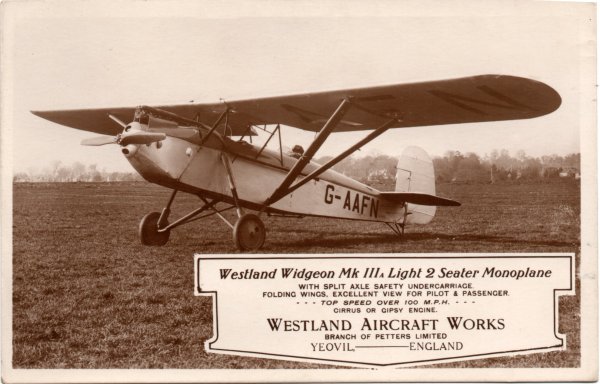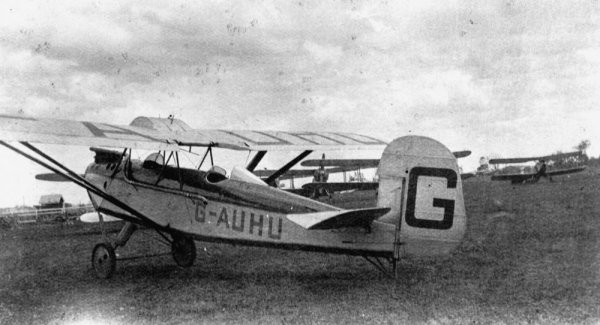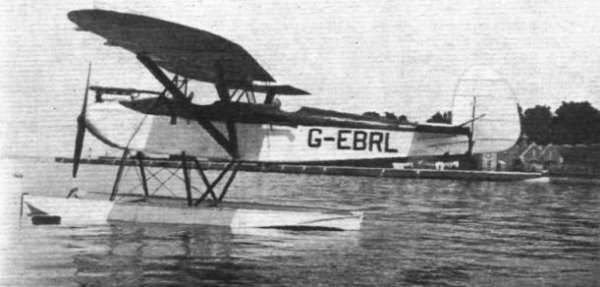Westland Widgeon
Westland Widgeon
A civil monoplane of the 1920s
The Westland
Widgeon was a
light aircraft
of the 1920s. A
single-engine
parasol
monoplane, the
Widgeon was
built in small
numbers before
Westland
abandoned
production in
1930.
In 1924, the
British Air
Ministry, eager
to encourage the
development of
cheap civil
aircraft
suitable for use
by private
owners and
flying clubs,
sponsored a
competition for
a two-seat ultra
light aircraft,
which had to be
powered by an
engine of 1100
cc displacement
or less and
capable of
carrying a load
of at least 340
lb (155 kg). To
meet this
requirement,
Westland
Aircraft
produced two
designs, the
Woodpigeon
biplane, and the
Widgeon parasol
monoplane.
Unable to decide
which design
would be
superior,
Westland decided
to build both
types.
The Widgeon first flew at Westland's Yeovil factory on 22 September 1924, eight days after the first of two Woodpigeons. Its fuselage, which was very similar to that of the Woodpigeon, was of mixed steel tube and wooden construction, while the wooden parasol wing, which was tapered in both chord and thickness, folded for easy storage. It was powered by a single 1,090 cc Blackburne Thrush three cylinder radial engine, which produced 35 hp (26 kW).
The Air Ministry Light Aircraft competition began at Lympne Aerodrome, Kent on 27 September. The Widgeon, which due to the use of the Thrush engine was badly underpowered (as was the Woodpigeon), crashed during the first day of trials. Despite this setback, it was clear that the Widgeon had promise and was superior to the Woodpigeon, and the damaged prototype was rebuilt with a more powerful 60 hp (45 kW) Armstrong Siddeley Genet engine as the Widgeon II. Despite its much greater weight, the new engine transformed the Widgeon, the rebuilt aircraft being almost 40 mph (64 km/h) faster.
Based on this experience, Westland decided to enter the Widgeon into production for the private owner. It was therefore redesigned with a simpler, constant chord, wing replacing the tapered wing of the Widgeon I and II to ease production. The resulting Widgeon III could be powered either a radial engine like the Genet or an inline engine such as the Cirrus. The first Widgeon III flew in March 1927, with production starting later that year. The design was further refined with a duralumin tube fuselage and a new undercarriage to produce the Widgeon IIIA.
The Widgeon proved expensive compared to its competitors and a total of only 26 of all types, including the prototype, were built and sold before production was stopped in 1930 in order to allow Westland to concentrate on the Wapiti general-purpose military aircraft and the Wessex airliner.
![]()
The various
Marks of Widgeon
- all built by
Westland, Yeovil
Widgeon I - Powered by one 35 hp Blackburne Thrush radial engine. One built.
Widgeon II - Rebuild of Widgeon I with 60 hp Armstrong Siddeley Genet radial.
Widgeon III - Redesign for production. Powered by ADC Cirrus II or III inline engine, Genet II radial, ABC Hornet or de Havilland Gipsy. 18 built.
Widgeon IIIA - Variant of Widgeon III with metal fuselage and new undercarriage. Powered by Cirrus or Gipsy engine. Seven built.
All the above text based on / 'borrowed' from Wikipedia.
gallery

From my
collection
A 1920's advertising postcard of the Westland Widgeon.

An contemporary photograph of a Widgeon.

A seaplane version of the Westland Widgeon.

Westland Widgeons - Marks II and III.